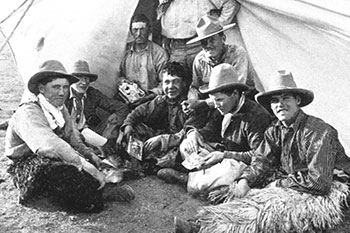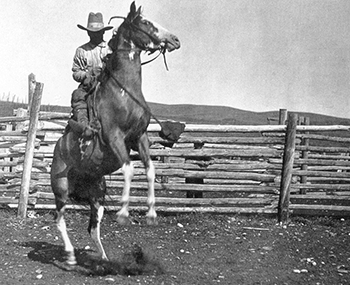
History
Bar U Ranch National Historic Site
Nestled between the rolling Porcupine Hills and the towering Rocky Mountains, surrounded by the prairie landscape and shaped by Chinook winds, the Bar U Ranch National Historic Site is one of the first and most enduring large corporate ranches of the West.
Most requested
Hometown Heroes
Profiles of military heroes associated Bar U Ranch National Historic Site during the First World War.
Photos and videos
A collection of photos and videos of Bar U Ranch National Historic Site
Steeped in history, the Bar U commemorates the history and importance of the ranching industry in Canada.
The Bar U Ranch was one of a small group of large corporate ranches in western Canada, including the Cochrane, the Oxley, the Walrond and the Quorn. From 1882 to 1950, the Bar U was one of the foremost ranching operations in Canada.

The key personalities associated with the Bar U - Fred Stimson, George Lane and Patrick Burns - were leaders in ranching. They involved the Bar U Ranch in many of the major issues which shaped the industry.
At the practical level, the Bar U was one of the best managed of the large ranches and served as a training ground for many cattlemen.
From 1881 to 1902, Fred Stimson and the North West Cattle Company practised open range ranching. Infrastructure at the ranch headquarters was kept to a minimum. This era opened with a sparse arrangement of buildings confined to the central and western end of the site. Stimson gradually added buildings, corrals and fences as he adapted to changing circumstances.
Under George Lane and his partners (1902-25), the Bar U achieved international repute as a centre of breeding excellence for cattle and purebred Percheron horses. The ranch was the linchpin of a business empire which included a number of ranches in the shortgrass prairie as well as, farms, meat packing factories and flour mills.
Developments on the site reflected this diversification and intensification. New barns, corral and feed preparation facilities accommodated the Percherons, while new residential buildings housed more staff.

During the Burns era (1927-50), the Bar U was part of a multi-ranch cattle operation. An experienced and resilient owner, Burns piloted his ranches through the depression, cutting back operating expenditures and investing in long-term improvements.
Much of the ranch's infrastructure became redundant as he scaled down the Percheron operation. Several buildings were adapted to store grain, which was grown in huge quantities during the Second World War.
The Bar U remained one of the largest ranches in the country until 1950, after which date the executors of the Burns estate sold land to other ranchers.
While most of the large ranches of the 1880s went out of business in the early 20th century, the Bar U has survived to the present day.
This long history, populated along the way by colourful characters like former slave John Ware and the outlaw The Sundance Kid, and the structures from the late 19th and early 20th centuries provide a direct link with the early years of ranching in Alberta.
Together they make the Bar U unique among historic ranches and provide an excellent opportunity to commemorate the ranching industry.
- Date modified :